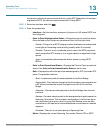
Managing MAC Address Tables
Managing Dynamic MAC Addresses
Cisco Small Business 200 Series Smart Switch Administration Guide 204
14
Managing Dynamic MAC Addresses
The Dynamic Address Table (bridging table) contains the MAC addresses
acquired by monitoring the source addresses of frames entering the device.
To prevent this table from overflowing and to make room for new MAC addresses,
an address is deleted if no corresponding traffic is received for a certain period.
This period of time is the aging interval.
Configuring Dynamic MAC Address Aging Time
To configure the aging interval for dynamic addresses:
STEP 1 Click MAC Address Tables > Dynamic Address Settings.
STEP 2 Enter Aging Time. The aging time is a value between the user-configured value
and twice that value minus 1. For example, if you entered 300 seconds, the aging
time is between 300 and 599 seconds.
STEP 3 Click Apply. The aging time is updated.
Querying Dynamic Addresses
To query dynamic addresses:
STEP 1 Click MAC Address Tables > Dynamic Addresses.
STEP 2 In the Filter block, you can enter the following query criteria:
• VLAN ID—Enter the VLAN ID for which the table is queried.
• MAC Address—Enter the MAC address for which the table is queried.
• Interface—Select the interface for which the table is queried. The query can
search for specific unit/slot, ports, or LAGs.
STEP 3 Enter the Dynamic Address Table Sort Key field by which the table is sorted. The
address table can be sorted by VLAN ID, MAC address, or interface.
STEP 4 Click Go. The Dynamic MAC Address Table is queried and the results are
displayed.


















